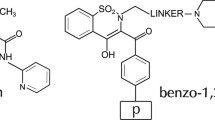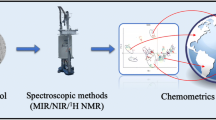Abstract
The purpose of this research was to analyze the pharmacological properties of a homologous series of nitrogen mustard (N-mustard) agents formed after inserting 1 to 9 methylene groups (-CH2-) between 2-N(CH2CH2Cl)2 groups. These compounds were shown to have significant correlations and associations in their properties after analysis by pattern recognition methods including hierarchical classification, cluster analysis, nonmetric multi-dimensional scaling (MDS), detrended correspondence analysis, K-means cluster analysis, discriminant analysis, and self-organizing tree algorithm (SOTA) analysis. Detrended correspondence analysis showed a linear-like association of the 9 homologs, and hierarchical classification showed that each homolog had great similarity to at least one other member of the series—as did cluster analysis using paired-group distance measure. Nonmetric multi-dimensional scaling was able to discriminate homologs 2 and 3 (by number of methylene groups) from homologs 4, 5, and 6 as a group, and from homologs 7, 8, and 9 as a group. Discriminant analysis, K-means cluster analysis, and hierarchical classification distinguished the high molecular weight homologs from low molecular weight homologs. As the number of methylene groups increased the aqueous solubility decreased, dermal permeation coefficient increased, Log P increased, molar volume increased, parachor increased, and index of refraction decreased. Application of pattern recognition methods discerned useful interrelationships within the homologous series that will determine specific and beneficial clinical applications for each homolog and methods of administration.
Similar content being viewed by others
References
Gareth T. Medicinal Chemistry. New York, NY: John Wiley and Sons; 2000.
Silverman R. The Organic Chemistry of Drug Design and Drug Action. San Diego, CA: Academic Press; 1992.
Pratt W, Ruddon R, Ensminger W, Maybaum J. The Anticancer Drugs. New York, NY: Oxford University Press; 1994.
Gringauz A. Introduction to Medicinal Chemistry. New York, NY: Wiley-VCH; 1997.
King F. Medicinal Chemistry Principles and Practice. Cambridge, UK: Royal Society of Chemistry; 2001.
Pain A, Samanta S, Dutta S, et al. Synthesis and evaluation of substituted naphthalimide nitrogen mustards as rationally designed anticancer compounds. Acta Pol Pharm. 2003;60:285–291.
Pain A, Samanta S, Dutta S, et al. Evaluation of napromustine, a nitrogen mustard derivative of naphthalimide, as a rationally designed mixed-function anticancer agent. Exp Oncol. 2002;24: 173–179.
Faissat L, Martin K, Chavis C, Montero J, Lucas M. New nitrogen mustards structurally related to (L)-Carnitine. Bioorg Med Chem. 2003;11:325–334.
Fousteris MA, Koutsourea AI, Arsenou ES, Papageorgiou A, Mourelato D, Nikolaropoulos SS. Antileukemic and cytogenetic effects of modified and non-modified esteric steroidal derivatives of 4-methyl-3-bis(2-chloroethyl)amino benzoic acid (4-Me-CABA). Anticancer Res. 2002;22:2293–2299.
Papageorgiou A, Nikolaropoulos S, Arsenou E, et al. Enhanced cytogenetic and antineoplastic effects by the combined action of 2 esteric steroidal derivatives of nitrogen mustards. Chemotherapy. 1999;45:61–67.
Baraldi P, Romagnoli R, Giovanna P, Nunez M, Bingham J, Hartley J. Benzoyland cinnamoyl nitrogen mustard derivatives of benzoheterocyclic analogues of thetallimustine: synthesis and antitumor activity. Bioorg Med Chem. 2002;10:1611–1618.
Chen Z, Wan W, Xu D. Studies on the synthesis of tetrapyrrole nitrogen mustards and their directed dual anti-tumor activities. J Chin Pharm Sci. 1998;7:230–231.
O’Conner C, Denny W, Fan J, Gravatt G, Grigor B, McLennan D. Hydrolysis and alkylating reactivity of aromatic nitrogen mustards. J Chem Soc. 1991;12:1933–1939.
Palmer B, Wilson W, Cliffe S, Denny W. Hypoxia-selective antitumor agents. 5. Synthesis of water-soluble nitroaniline mustards with selective cytotoxicity for hypoxic mammalian cells. J Med Chem. 1992;35:3214–3222.
Catsoulacos P, Camoutsis C, Pelecanou M. Antileukemic activity of homo-azasteroidal esters of the isomers of N,N-bis(2-chloroethyl) aminocinnamic acid. Eur J Med Chem. 1991;26:659–661.
Hartley J, Preti C, Wyatt M, Lee M. Design, synthesis and biological evaluation of benzoic acid mustard derivatives of imidazole-containing and C-terminal carboxamide analogs of distamycin. Drug Des Discov. 1995;12:323–335.
Brooks N, McHugh P, Lee M, Hartley J. The role of base excision repair in the repair of DNA adducts formed by a series of nitrogen mustard-containing analogues of distamycin of increasing binding site size. Anticancer Drug Des. 1999;14:11–18.
Kovalenko S. Effect of basicity and details of chemical structure on the mutagenic activity of nitrogen mustards. Genetika. 1972; 8:100–103.
Bartzatt R, Donigan L. Two identical twin nitrogen mustard agents that express rapid alkylation activity at physiological pH 7.4 and 37°C. Lett Drug Des Discov. 2004;1:78–83.
Herroro J, Valencia A, Dopazo J. A hierarchical unsupervised growing neural network for clustering gene expression patterns. Bioinformatics. 2001;17:126–136.
Palm K, Stenberg P, Luthman K, Artursson P. Polar molecular surface properties predict the intestinal absorption of drugs in humans. Pharm Res. 1997;14:568–571.
Ertl P, Bernhard R, Selzer P. Fast calculation of molecular polar surface area as a sum of fragment-based contributions and its application to the prediction of drug transport properties. J Med Chem. 2000;43: 3714–3717.
Clark D. Rapid calculation of polar molecular surface area and its application to the prediction of transport phenomena. 2. Prediction of blood-brain barrier penetration. J Pharm Sci. 1999;88:815–821.
Hansch C, Leo A, Hockman D. Exploring QSAR: Hydrophobic, Electronic, and Steric Constants. ACS Professional Reference Book. Washington, DC: The American Chemical Society; 1995.
Johnson R, Wichern D. Applied Multivariate Statistical Analysis. Englewood Cliffs, NJ: Prentice Hall Inc; 1992.
Dundteman G. Introduction to Multivariate Analysis. Beverly Hills, CA: Sage Publication; 1994.
Anderberg M. Cluster Analysis for Applications. San Diego, CA: Academic Press; 1973.
Schiffman S, Reynolds M, Young F. Introduction to Multidimensional Scaling: Theory, Methods, and Applications. New York, NY: Academic Press; 1981.
Lipinski A, Lombardo F, Dominy B, Feeney P. Experimental and computational approaches to estimate solubility and permeability in drug discovery and development settings. Adv Drug Deliv Rev. 1997;23:3–25.
Greenacre MJ. Correspondence Analysis in Practice. London, UK: Academic Press; 1993.
Hardy I, Cook W. Predictive and correlative techniques for the design, optimization and manufacture of solid dosage forms. J Pharm Pharmacol. 2002;55:3–18.
Mareno M, Magalhaes N, Cavalcanti C, Alves A. Hierarchical cluster analysis applied to drug design. Quim Nova. 1996; 19:594–599.
Fossler M, Chang K, Young D. The use of cluster analysis in pharmacokinetics. Acta Pharm Jugosl. 1990;40:225–236.
Wermuth CG. The Practice of Medicinal Chemistry. San Diego, CA: Academic Press; 1996.
Aboul-Fadl T, Mahfouz N. Metronidazole twin ester prodrugs. 2. Non identical twin esters of metronidazole and some antiprotozoal halogenated hydroxy-quinoline derivatives. Sci Pharm. 1998;66:309–324.
Mahfouz N, Aboul-Fadl T, Diab A. Metronidazole twin ester prodrugs: synthesis, physiochemical properties, hydrolysis kinetics and antigiardial activity. Eur J Med Chem. 1998;33:675–683.
Rinaki E, Valsami G, Macheras P. Quantitative biopharmaceutics classification system: the central role of dose/solubility ratio. Pharm Res. 2003;20:1917–1925.
Lobenberg R, Amidon G. Modern bioavailability, bioequivalence and biopharmaceutics classification system: new scientific approaches to international regulatory standards. Eur J Pharm Biopharm. 2000; 50:3–12.
Author information
Authors and Affiliations
Corresponding author
Additional information
Published: April 14, 2006
Rights and permissions
About this article
Cite this article
Bartzatt, R., Donigan, L. Applying pattern recognition methods to analyze the molecular properties of a homologous series of nitrogen mustard agents. AAPS PharmSciTech 7, 35 (2006). https://doi.org/10.1208/pt070235
Received:
Accepted:
DOI: https://doi.org/10.1208/pt070235




